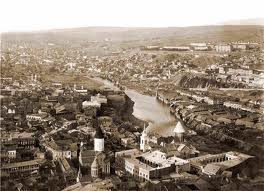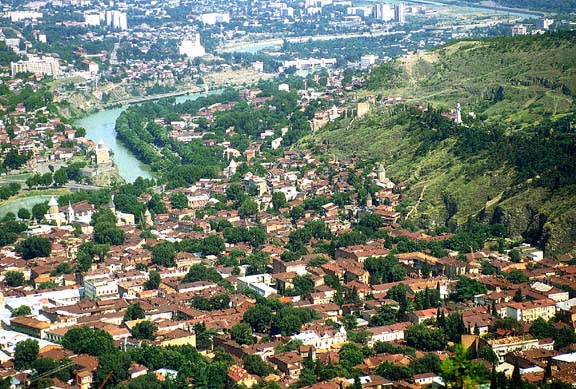 |
 |
||
|
| |||
|
HOME
PROGRAM
ORGANIZING COMMETTEE
PARTICIPANTS
REGISTRATION
USEFUL LINKS
CONTACT
|
HOMEWelcome to the Conference on Future Perspectives in High-Energy Physics 2011 "Physics in the LHC era", October 17-21, 2011, TSU, Tbilisi, Georgia
The conference will be held at TSU, II building, 135.
For the next conference, aiming to remain the core accent on physics of particles and taking into consideration the desire of Georgian physicists upon making the conference traditional (as well as the scientific community has been being expected for the long-term journey to the mysteries of microcosm after the LHC start up) it was decided that the conference should be given on the one hand very ambitious , but on the other hand all-embracing title: ,,Physics in the LHC Era”. The first three conferences in 2001, 2003 and 2005 were held under the aegis of Georgian Academy of Sciences and Ivane Javakhishvili Tbilisi State University and since 2007 all responsibilities to the conference carrying out have been incurred by Ivane Javakhishvili Tbilisi State University. Nowadays, the 6th conference is being prepared for carrying out with support of Georgian Academy of Sciences and the Ministry of Education and Science of Georgia. It is noteworthy that the history of these traditional conferences is not long-standing, but nevertheless the scientific community tries to get informed thoroughly on the upcoming activities and accordingly take the most active part in them. Therefore, dear colleagues, in order to share the latest achievements, you are most welcome to Georgia for participation in the 6th conference: ,,Physics in the LHC Era” . Don´t forget that ,,Science brings nations together”... including high Energy Physics too. Historical preview of Tbilisi
The foundation of the city has come down to us as legend. One day King Vakhtang Gorgasali was hunting with his retinue in impenetrable woods whitchj at that time covered the slopes of the Mtkvari (Kura) Valley. While pursuing his game the king lost sight of the rest of the hunters. Suddenly a pheasant came flying out of bushes. The king hit him with an arrow.When he dismounted and wanted to pick up his bag he found that the pheasants had fallen into a hot spring and was cooked. The retinue found its ruler immersed in thought by a hot spring. King Vakhtang announced that a town would be built there and the he would name it TBILISI, “City of Warm Springs” in Georgian. Tbilisi was repeatedly invaded all through the many centuries of its history. In the 730s the town passed into the hands of the Arabs who ruled in Transcaucasia for several centuries. Despite intervention and destruction, Tbilisi was in the XII-XIII centuries one of the populous and economically well developed towns of the Middle East. important During the subsequent epoch, however, Tbilisi gradually fell into decay. This was caused by the constant invasions of enemy hordes and the break-up of the united Georgian state. It is estimated, that during this epoch Tbilisi was captured and razed to the ground more than 80 time ! The last time the city was subjected to a destructive attack of the Persian Shah Agha Mohammed Khan in 1795. A peaceful era of development in the history of Tbilisi started at the turn of the XIX century. Though Georgia was annexed by the Russian Empire, the repressive Russian regime brought political and ecnomical stability to the country. The construction ofthe Transcaucasian Railway provided for the city a convenient egress to the most land and sea communications; a number of industrial enterprises were put into operation; trade and handicraft rapidly increased. Considerable changes occurred in the cultural life of the city; the network of the schools expanded, newspapers and magazine began to be published and thatres opened. (Unfortunately, thess changes were accompanied by a repressive policy of Russification of the local population.) The population of the city substantially increased and by 1897 numbered almost 200,000 men. Another major period in the history of Tbilisi began with the Independence of Georgia in 1918. Though the sovereign country lived for only three years, Tbilisi prospered and achieved a new level. Tbilisi State University was established in 1918 and many new enterprises put into operation. Yet, these developments were checked by the annexation of Georgia by the Soviet Russia in 1921.
Still the city found its own way to prosper under the Soviet Regime. New districts were built, institutions established; an important project – embankment of the Mtkvari River, initiated in 1930, that prevented the annual deluges and floods. Though the first horse tramway was put into operation in 1883 along the present Agmashenebli Avenue, it was in 1937 the the first city trolley-bus traffic started on the same route. The location and appearance of Tbilisi are unique. The city is surrounded on three sides by the slopes of Trialeti and Saguramo-Ialoni ranges. The hollow in which Tbilisi lies merges with Lower Kartli Plain in the south-east and the Samgori plain in the east.Most of the city lies on the different slopes from 380 to 550 m. above the sea level. As you approache Tbilisi, you can see Mount Mtatsminda (“The Holy Mountain”) from far afar. At the foot of the mountain is the lower station of the funicular railway, while on the plateau that crowns the mountain is one of the city’s parks, a large and beautiful building of the upper station and the TV tower. On the steep slope of the mountain, just above its foot, stands as though grown in the cliff, the ancient St. David Monastery. Its cemetery has a pantheon containing the graves of outstanding Georgian writers and public figures. Here Nikoloz Baratshvili, Ilya CHavchavadze, Akaki Tsereteli, Vazha Pshavela, Yakob Gogebashvili, Niko Nikoladze, Galaktion Tabidze, Georgi Lebanidze, Iosif Grishashvili, Simon Chikovani and others found their last Peace. The city itself is a combination of Western and Eastern architecture and culture. The Old City has a narrow, winding and steep streets with typically oriental style. A unique hot spring bathes, that had excited King Vakhtang, are still functioning to the pleasure of visitors. The Narikala Fortress dominates this part of the city.
In our days, the square is fundamentally reconstructed and a beautifull square with paved road was made. The City Hall building faces from the one side. On the opposite side there is a monument to Alexander Pushkin, great Russian poet who lived in Tbilisi in 1829, and a street named after him runs nearby. Not far from the Independence square is a beautifull Neo-Classic building – a former residence of the vice-regent of the Emperor of Russia in Transcaucasia. On the opposite side of the Rustaveli Avenue stands the Kashveti Temple well known for its finest stone ornamentation. Further up the street visitor will find Rustaveli Theater with its domimant and unique facade, Paliashvili Opera house built in a graceful pseudo-moresque style. In the middle part of the avenue, one can find the Supereme Court of Georgia with its grand colonade; Academy of Science of Georgia built in Neo-Gothic style and crowned with a tall tower. Nearby is a newly erected monument to the greatest Georgian King, David Agmashenebeli….
Clips about Tbilisi/Georgia:
|
||
 T’bilisi or Tbilisi, formerly Tiflis, capital and largest city of Georgia, in the east central part of the country. The city, situated on the Kura River in a valley sheltered by the Caucasus Mountains, is a major economic, transportation, and cultural center. Tbilisi is mentioned in Georgian annals for the first time in connection with the events occurred in the IV century C.E. At that time it was already a powerful fortress which played an important defensive role in the struggle of the Georgian kingdom against foreign invaders, the Persians in particular.
T’bilisi or Tbilisi, formerly Tiflis, capital and largest city of Georgia, in the east central part of the country. The city, situated on the Kura River in a valley sheltered by the Caucasus Mountains, is a major economic, transportation, and cultural center. Tbilisi is mentioned in Georgian annals for the first time in connection with the events occurred in the IV century C.E. At that time it was already a powerful fortress which played an important defensive role in the struggle of the Georgian kingdom against foreign invaders, the Persians in particular.
 Among the main street of the city Rustaveli Avenue is noted for the beauty of its buildings and its luxuriant verdure. In the beginning of the avenue is the central square of the city – The Independence Square. In the 1850s a huge caravan-serai building was erected in the middle of this square. It was the first modern theatre building in the Transcaucasia and was richly decorated by G.G. Gagarin, well-known Russian artist who then served in Georgia. According to Alexander Dumas (the Father), in its beauty the theatre vied with the worlds best theatres of the times. In 1874 the theatre burned down and the owner of the caravan-serai prohibited its restoration.
Among the main street of the city Rustaveli Avenue is noted for the beauty of its buildings and its luxuriant verdure. In the beginning of the avenue is the central square of the city – The Independence Square. In the 1850s a huge caravan-serai building was erected in the middle of this square. It was the first modern theatre building in the Transcaucasia and was richly decorated by G.G. Gagarin, well-known Russian artist who then served in Georgia. According to Alexander Dumas (the Father), in its beauty the theatre vied with the worlds best theatres of the times. In 1874 the theatre burned down and the owner of the caravan-serai prohibited its restoration.